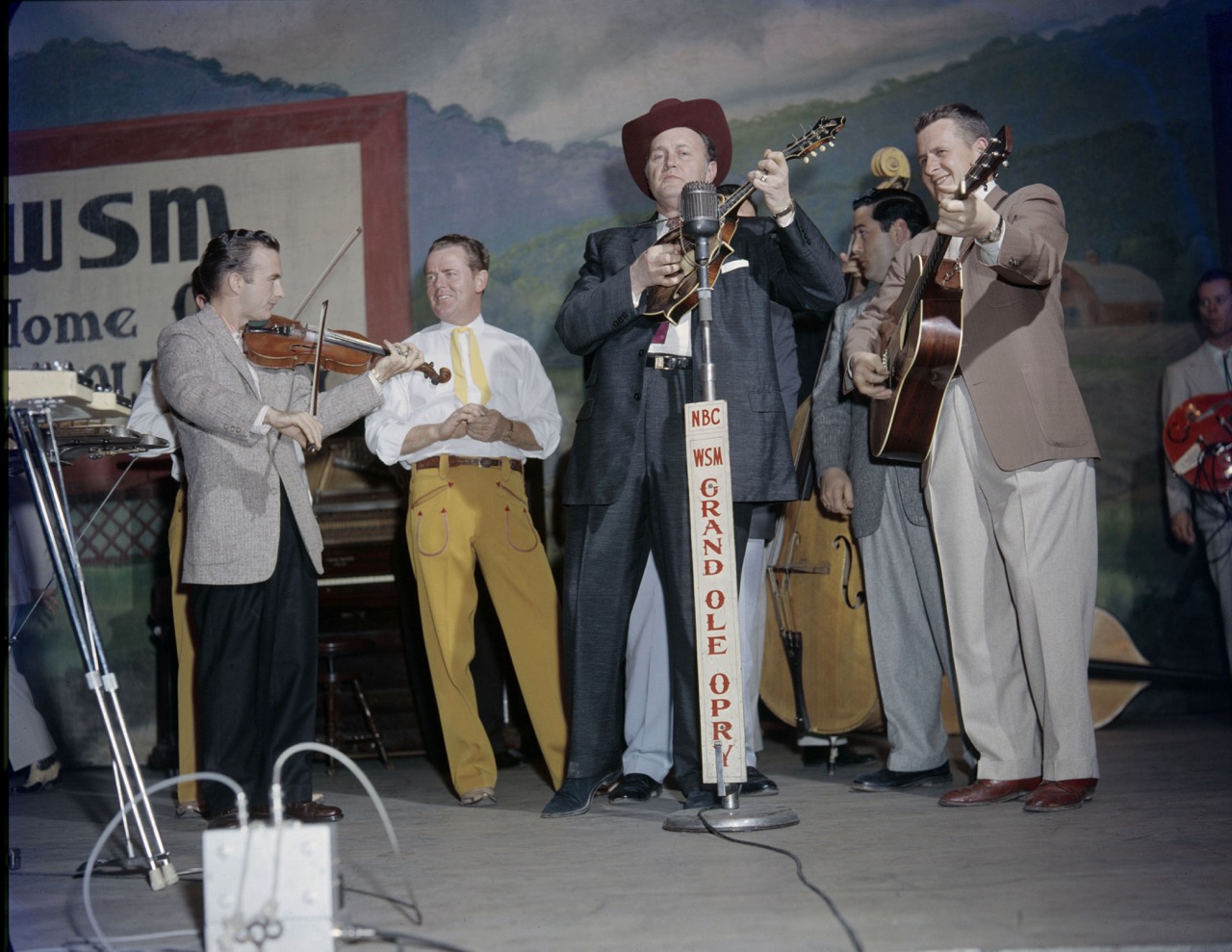BLUEGRASS RAMBLES: The Big Stories of Roots Music on the Small Screen

Bill Monroe on the Grand Ole Opry, Nashville, 1958. (photo from the Les Leverett Collection, via PBS)
Having recently watched BBC’s Lost Highway: the Story of Country Music has me yearning to see the PBS broadcast of Big Family: The Story of Bluegrass Music over Labor Day weekend, and Ken Burns’ eight-part PBS documentary Country Music to be released starting Sept. 15. For lovers of American music, these shows all offer a veritable feast. The continuing role of public broadcasting in showcasing and teaching the huge range of bluegrass, country, and American music more generally has been little noted in the music community. But even before these big films came around, there were public broadcasting showcases such as Austin City Limits, which began its now 44-year run with Willie Nelson on Nov. 15, 1975, and has featured major and emerging music acts ever since.
A common thread that weaves across 2003’s Lost Highway: The Road to Country Music is change and the struggle between artistic development and cultural conservatism. The four episodes lovingly recreate the early days, going back beyond Ralph Peer and the “Big Bang of Country Music.” From there, there’s footage and discussion of Hank Williams, the Nashville Sound, the Bakersfield Sound, the emergence of the Outlaws, and then the development of modern country, including The Dixie Chicks and other favorites. The interviews and videos included in the three episodes people have put on YouTube leave a country music lover or student itching for more to treasure, learn, and enjoy. Unfortunately, there doesn’t seem to be an option for buying the complete series from the BBC.
Public TV station KET (Kentucky Educational Television) will be premiering a two-hour film called Big Family:The Story of Bluegrass Music nationally on PBS on Aug. 30 after a series of free previews in Kentucky this summer. If you can’t get to one of these preview showings, set your DVR to record this treat, which specifically focuses on bluegrass in all its forms and manifest changes. Exploring the background, present state, and possible futures represented by the youthful creative energy enlivening bluegrass at festivals, at colleges and universities, and in jams around the country, this engaging film will also prove to be a tasty warmup for the Ken Burns marathon to begin two weeks later, as well as be highly entertaining in its own right.
Ken Burns is well known for his massive documentary films telling the American story using long-thought-lost old films along with photographs and interviews to bring American history to life. He developed his own documentary style, combining archival film and photographs into a free-flowing narrative, read by noted actors. His works include The Civil War, Baseball, The Statue of Liberty, Jazz, and many more. He has won more awards than I have room to list here from his base in rural Walpole, New Hampshire. While anchored in history, his films also stand as metaphors for the American story while being highly entertaining, too. Into this list of works, Country Music will inject a new, clear, and probably different take on country music’s nature and importance to our culture and life.
Before saying, “That ain’t country,” or “That ain’t bluegrass,” or any other “that ain’t,” you should digest the larger story of the birth and growth of American music as Burns and his team have presented them, always remembering that the story reaches far beyond any boundaries of time or geography — to Africa, Europe, Asia, and forward to we know not where. As you watch the film, you might be tempted to say, “My favorite song isn’t there” or realize your favorite artist isn’t represented. This fact expresses the truth that one film, even at 16 hours, cannot be an encyclopedia, and your favorite music cannot be guaranteed within an anthology. Such filmmaking requires choices and decisions to be made in order to tell a coherent tale. But this eight-part extravaganza showing the broad range of how country music has evolved throughout our and its history should go a long way toward filling holes for some while opening areas for further exploration for others. (You can watch a longer preview here.)
Ken Burns doesn’t provide an encyclopedia on your favorite niche in the music world, but he urges you to take a larger and more comprehensive view of where your favorites fit in, and, maybe, just maybe, expand your own borders.






